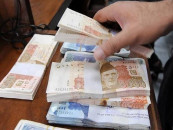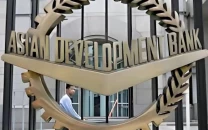Data anomaly puts question mark over economy’s size
Statistics bureau and Suparco have different crop figures.

According to estimates of key crops for 2012-13, the Pakistan Bureau of Statistics projected production of 24.2 million tons of wheat compared to 26.3 million tons estimated by Suparco. PHOTO: FILE
According to the survey released on June 11, the economy grew 3.6%, based on nine-month data, in 2012-13 and fell short of the full-year target of 4.1% set in the budget. In the overall economy, the agriculture sector grew 3.3% compared to the target of 4.1%.
The Annual Plan 2013-14 says crop reporting services of provincial governments compile crop data and send it to the Pakistan Bureau of Statistics (PBS) that prepare national accounts with the help of these figures.

The entire planning including assessment of the agriculture sector is based on the statistics provided through this mechanism that has remained a sole source of crop data in the country since long.
However, with the start of monitoring of crops by the Pakistan Space and Upper Atmosphere Research Commission (Suparco) through satellite technology, a different set of information has come to light, raising questions over the reporting system in vogue.
According to estimates of key crops for 2012-13, the Pakistan Bureau of Statistics projected production of 24.2 million tons of wheat compared to 26.3 million tons estimated by Suparco.
In the same way, PBS expected an output of 5.51 million tons of rice, 62.4 million tons of sugarcane and 13.1 million bales of cotton. In comparison, Suparco saw production of 7.2 million tons of rice, 68.5 million tons of sugarcane and 13.9 million bales of cotton, showing a higher output for the three crops.
The Annual Plan points to the clear difference between data from the two sources. “Such glaring dissimilarity can never be ignored and need attention at the appropriate level. It is time to address this anomaly,” the plan stresses.
The Suparco system is based on state-of-the-art technologies authenticated by the Food and Agricultural Organization of the United Nations.
“If we could resolve to account for the actual information, it may actualise the real size of overall GDP of Pakistan,” says the Annual Plan.
A senior government official, however, said Suparco data on the area of cultivated crops was credible, but PBS figures showing production of different crops were more authentic.
He said the government was using production figures compiled by the PBS because it had a network spread across the country that assessed crop yields.
Published in The Express Tribune, June 15th, 2013.
Like Business on Facebook to stay informed and join in the conversation.



















COMMENTS
Comments are moderated and generally will be posted if they are on-topic and not abusive.
For more information, please see our Comments FAQ